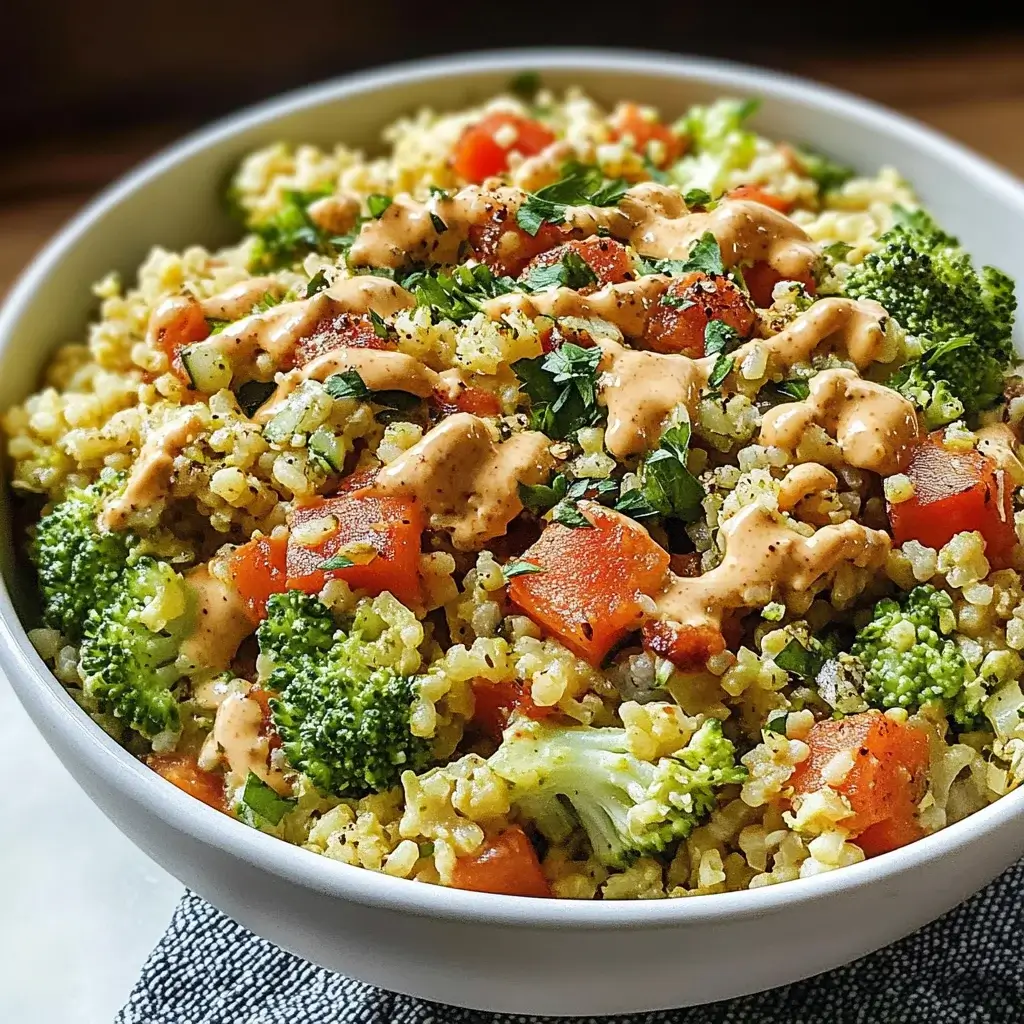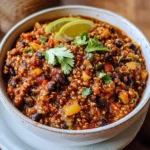The first time I made these Cauliflower Vegetarian Rice Bowls, I was a little skeptical. My family, particularly my husband, can be a bit hesitant when “vegetarian” and “healthy” are the main descriptors for dinner. Cauliflower rice, in particular, had a mixed track record in our house. But I was determined to find a vibrant, satisfying meal that was packed with nutrients and didn’t leave us feeling heavy. I’d seen countless beautiful bowl recipes online and decided to create my own spin, focusing on roasted vegetables for maximum flavor and a creamy, dreamy tahini dressing. The aroma that filled the kitchen as the cauliflower, chickpeas, and sweet potatoes roasted was the first good sign – a warm, slightly spicy, and inviting scent. When it came time to assemble, the colors alone were a feast for the eyes: deep orange from the sweet potatoes, golden roasted chickpeas, vibrant green spinach, and the creamy white of the cauliflower rice, all drizzled with that luscious dressing. The real test, of course, was the tasting. My youngest, usually a critic of anything too “vegetable-forward,” actually asked for seconds of the “crunchy yellow peas” (chickpeas) and “orange sweet stuff.” My husband, to my surprise, declared it “surprisingly hearty” and admitted the tahini dressing was “restaurant-quality.” For me, it was a revelation – a meal that was not only incredibly healthy and aligned with my desire for more plant-based eating but also genuinely delicious, satisfying, and, importantly, family-approved. It has since become a staple in our weekly rotation, a testament to how versatile and delightful cauliflower rice bowls can truly be.
Ingredients
For the Roasted Vegetables & Cauliflower Rice:
- 1 large head of cauliflower (about 2 lbs): Grated or processed into rice-like consistency for the base, and another portion cut into small florets for roasting, providing texture and nutty flavor.
- 1 large sweet potato (about 1 lb): Peeled and diced into ½-inch cubes, offering natural sweetness and a vibrant color.
- 1 (15-ounce) can chickpeas: Rinsed, drained, and patted thoroughly dry, for a protein boost and delightful crunch when roasted.
- 1 red onion: Sliced thinly, adding a pungent sweetness and color contrast when lightly roasted or served raw.
- 4 cups fresh spinach or kale: Roughly chopped, to be wilted slightly or added fresh for a boost of greens.
- 3 tablespoons olive oil: Extra virgin, divided, for roasting the vegetables and sautéing the cauliflower rice, ensuring a golden-brown finish and flavor.
- 1 teaspoon smoked paprika: Adds a deep, smoky flavor to the roasted vegetables.
- ½ teaspoon ground cumin: Provides earthy warmth.
- ½ teaspoon garlic powder: For an all-around savory note.
- ¼ teaspoon turmeric powder (optional): For color and its anti-inflammatory properties.
- Salt and freshly ground black pepper: To taste, enhancing all the other flavors.
For the Creamy Tahini Dressing:
- ½ cup tahini: Good quality, runny tahini is best, forming the creamy, nutty base of the dressing.
- ¼ cup fresh lemon juice: Adds brightness and acidity to balance the richness of the tahini.
- 2-3 tablespoons maple syrup or agave nectar: For a touch of sweetness; adjust to your preference.
- 1-2 cloves garlic: Minced or grated, for a pungent kick.
- 4-6 tablespoons ice-cold water: To thin the dressing to the desired consistency; ice water makes it extra creamy.
- Pinch of salt: To taste.
Optional Garnishes:
- Fresh cilantro or parsley: Chopped, for freshness and color.
- Toasted sesame seeds: For added texture and nutty flavor.
- Avocado slices: For creaminess and healthy fats.
- A sprinkle of red pepper flakes: For a touch of heat.
Instructions
- Prepare the Cauliflower:
- Preheat your oven to 400°F (200°C). Line two large baking sheets with parchment paper for easy cleanup.
- Cut about half of the cauliflower head into small, bite-sized florets.
- Grate the remaining half of the cauliflower using the large holes of a box grater, or pulse it in a food processor until it resembles coarse rice. Be careful not to over-process, or it will become mushy. Set the cauliflower rice aside.
- Roast the Vegetables:
- In a large bowl, combine the cauliflower florets, diced sweet potato, and drained chickpeas.
- Drizzle with 2 tablespoons of olive oil. Sprinkle with smoked paprika, cumin, garlic powder, turmeric (if using), salt, and pepper. Toss everything thoroughly to ensure the vegetables and chickpeas are evenly coated.
- Spread the seasoned vegetables and chickpeas in a single layer on one of the prepared baking sheets. Avoid overcrowding the pan; use two sheets if necessary for even roasting and crisping.
- If using red onion for roasting, toss it with a little olive oil, salt, and pepper, and add it to the baking sheet with the other vegetables for the last 10-15 minutes of roasting, or reserve to add raw later.
- Roast for 25-35 minutes, flipping halfway through, until the sweet potatoes are tender and slightly caramelized, the cauliflower florets are golden brown and tender-crisp, and the chickpeas are lightly crisped.
- Prepare the Cauliflower Rice:
- While the vegetables are roasting, heat the remaining 1 tablespoon of olive oil in a large skillet or wok over medium heat.
- Add the prepared cauliflower rice to the skillet. Sauté for 5-7 minutes, stirring occasionally, until it’s tender-crisp and lightly golden. Season with a pinch of salt and pepper. Be careful not to overcook, as it can become watery.
- If using spinach or kale and you prefer it wilted, add it to the skillet with the cauliflower rice during the last 1-2 minutes of cooking, stirring until just wilted. Alternatively, you can serve the greens fresh.
- Make the Creamy Tahini Dressing:
- In a small bowl or jar, whisk together the tahini, lemon juice, maple syrup (or agave), and minced garlic.
- The mixture will likely seize up and become very thick. Gradually whisk in the ice-cold water, one tablespoon at a time, until the dressing reaches a smooth, pourable consistency similar to heavy cream. You might need more or less water depending on your tahini.
- Season with a pinch of salt to taste. Adjust lemon juice or sweetener if needed.
- Assemble the Bowls:
- Divide the cooked cauliflower rice among four serving bowls. This forms the base of your vibrant meal.
- Arrange a generous portion of the roasted vegetables (sweet potato, cauliflower florets, chickpeas) over the cauliflower rice in each bowl.
- If you saved the red onion to serve raw, scatter it over the vegetables now. If you added fresh spinach/kale instead of wilting, add it to the bowls.
- Drizzle generously with the creamy tahini dressing.
- Garnish with optional toppings like fresh cilantro or parsley, toasted sesame seeds, avocado slices, or a sprinkle of red pepper flakes. Serve immediately and enjoy!
Nutrition Facts
- Servings: 4 large bowls
- Calories per serving: Approximately 450-550 kcal (This is an estimate and can vary based on specific ingredient brands, exact quantities, and optional additions like avocado.)
- Protein: Approximately 15-18g. Primarily from chickpeas and tahini, crucial for muscle repair, satiety, and overall bodily functions in a vegetarian diet.
- Fiber: Approximately 12-15g. High fiber content from cauliflower, sweet potatoes, chickpeas, and spinach aids digestion, promotes fullness, and helps regulate blood sugar levels.
- Healthy Fats: Approximately 25-30g. Sourced mainly from olive oil and tahini (monounsaturated and polyunsaturated fats), which are important for heart health and nutrient absorption.
- Vitamin C: High. Abundant in cauliflower and sweet potatoes, an essential antioxidant that supports the immune system and collagen production.
- Complex Carbohydrates: Provides sustained energy, primarily from sweet potatoes and chickpeas, offering a more gradual release of glucose compared to simple carbs.
(Disclaimer: Nutritional information is an estimate and may vary.)
Preparation Time
- Prep Time: Approximately 20-25 minutes. This includes washing and chopping the vegetables, preparing the cauliflower rice, and mixing the dressing. Using pre-cut vegetables or pre-made cauliflower rice can significantly reduce this time.
- Cook Time: Approximately 25-35 minutes. This is primarily for roasting the vegetables until tender and caramelized. The cauliflower rice cooks quickly while the vegetables are in the oven.
- Total Time: Approximately 45-60 minutes. A wonderfully efficient meal for a weeknight, offering a complex array of flavors and textures with relatively straightforward steps.
How to Serve
These Cauliflower Vegetarian Rice Bowls are incredibly versatile and can be presented in various appealing ways:
- Classic Bowl Presentation:
- Start with a bed of fluffy cauliflower rice at the bottom of each bowl.
- Artfully arrange distinct sections of roasted sweet potatoes, roasted cauliflower florets, and crispy chickpeas on top.
- Nestle fresh spinach or kale either under the roasted veggies (it will wilt slightly from the heat) or alongside them.
- Scatter thinly sliced red onions (if using raw) for a pop of color and bite.
- Drizzle generously with the creamy tahini dressing, ensuring it cascades over all components.
- Finish with a sprinkle of fresh herbs like cilantro or parsley, and perhaps some toasted sesame seeds or red pepper flakes.
- Deconstructed Platter (Family Style):
- Arrange the cooked cauliflower rice in a large mound on a platter.
- Place bowls of each roasted vegetable component (sweet potatoes, cauliflower, chickpeas) around the rice.
- Have a bowl of fresh greens and the tahini dressing on the side.
- This allows everyone to build their own bowl according to their preferences, which is great for families or gatherings with varying tastes.
- Meal Prep Perfection:
- Portion the cauliflower rice into individual meal prep containers.
- Add the roasted vegetables and chickpeas next to the rice (not on top, to prevent sogginess if dressing is added too early).
- Keep the tahini dressing in small separate containers.
- Pack fresh greens separately or add them just before serving.
- When ready to eat, you can gently reheat the rice and veggies (or eat cold/room temperature) and then drizzle with dressing and add greens.
- Buffet Style for Gatherings:
- Set up a “bowl bar” with large bowls of each component:
- Cauliflower rice (kept warm if possible)
- Roasted sweet potatoes
- Roasted cauliflower florets
- Roasted chickpeas
- Fresh spinach/kale
- Sliced red onions
- Tahini dressing
- A variety of garnishes: chopped nuts (almonds, walnuts), seeds (pumpkin, sunflower, sesame), avocado, different fresh herbs, lemon wedges, hot sauce.
- This encourages interaction and customization, making it a fun and engaging meal for guests.
- Set up a “bowl bar” with large bowls of each component:
- Add-On Ideas for Serving:
- Serve with a side of warm pita bread or naan for scooping up any leftover dressing and veggies.
- A small bowl of hummus or baba ghanoush can complement the Mediterranean flavors.
- Offer lemon wedges on the side for those who like an extra citrusy zing.
Additional Tips
- Mastering Cauliflower Rice: For the best texture, avoid over-processing your cauliflower in the food processor; aim for rice-sized grains, not a paste. If using a box grater, the large holes work perfectly. Don’t overcrowd the skillet when cooking, and avoid adding too much liquid, as this can make it soggy. Sautéing until just tender-crisp is key.
- Achieve Crispier Chickpeas: The secret to crispy roasted chickpeas is to rinse, drain, and then pat them very dry with paper towels or a clean kitchen towel before tossing with oil and spices. Roasting them at a high temperature (400°F/200°C) also helps achieve that desirable crunch.
- Don’t Overcrowd Roasting Pans: For beautifully caramelized and roasted vegetables (not steamed!), spread them in a single layer on your baking sheets. Use two sheets if necessary. This allows hot air to circulate around each piece, promoting browning and flavor development.
- Dressing Consistency is Key: Tahini can vary greatly in thickness. If your dressing is too thick even after adding the initial water, continue adding ice-cold water, a teaspoon at a time, whisking well after each addition, until it’s smooth and pourable. The ice water helps emulsify it into a creamier texture.
- Spice it Up or Down: This recipe is a great canvas for different flavor profiles. Feel free to adjust the spices for roasting. Add a pinch of cayenne pepper for heat, some dried oregano for a more Mediterranean feel, or even a curry powder blend for an Indian-inspired twist.
- Meal Prep Strategy: This bowl is fantastic for meal prepping. Roast a big batch of vegetables and cook the cauliflower rice over the weekend. Store them in separate airtight containers in the fridge. The dressing can also be made ahead and stored for up to a week. Assemble just before serving or pack into individual containers for grab-and-go lunches.
- Make it Even More Nutrient-Dense: Boost the nutritional content by adding other vegetables to the roasting pan, such as bell peppers, zucchini, or broccoli. You can also stir in some quinoa or brown rice with the cauliflower rice for added whole grains and protein if you’re not strictly aiming for low-carb.
- Don’t Skip the Garnishes: Fresh herbs like cilantro or parsley, toasted seeds, or a few slices of creamy avocado can elevate the bowl from simple to spectacular. They add freshness, texture, and visual appeal, making the meal even more enjoyable.
FAQ Section
Q1: Can I use frozen cauliflower for the rice or florets?
A1: Yes, you absolutely can use frozen cauliflower. For cauliflower rice, thaw the frozen riced cauliflower completely and pat it very dry with paper towels to remove excess moisture before sautéing. This prevents it from becoming soggy. For florets, you can roast them directly from frozen, though they might need a few extra minutes in the oven and may not get as crispy as fresh cauliflower. Ensure they are spread in a single layer and not overcrowded.
Q2: Is this recipe vegan?
A2: Yes, this recipe is inherently vegan as written, provided you use maple syrup or agave nectar in the tahini dressing instead of honey. All other core ingredients (vegetables, chickpeas, tahini, olive oil, spices) are plant-based.
Q3: Is this recipe gluten-free?
A3: Yes, this recipe is naturally gluten-free. Cauliflower rice is a gluten-free alternative to traditional grains, and all other listed ingredients (vegetables, chickpeas, tahini, spices) do not contain gluten. Always double-check labels on packaged goods like spices or tahini if you have celiac disease or severe gluten sensitivity to ensure no cross-contamination.
Q4: How can I make this recipe lower in carbs or keto-friendly?
A4: This recipe is already relatively low in carbohydrates due to the cauliflower rice base. To make it even more keto-friendly, you would need to omit or significantly reduce the sweet potato, as it’s higher in carbs. You could replace it with lower-carb vegetables like bell peppers, zucchini, or more cauliflower florets. Ensure your tahini dressing uses a keto-friendly sweetener or omit the sweetener altogether if preferred. Chickpeas are moderately carby for strict keto, so you might reduce their quantity or substitute with a lower-carb protein source like pan-fried halloumi (if vegetarian, not vegan) or additional low-carb nuts/seeds.
Q5: How long will these cauliflower rice bowls last in the fridge?
A5: When stored properly, components of the cauliflower rice bowls can last for a good few days. Cooked cauliflower rice and roasted vegetables will keep well in airtight containers in the refrigerator for 3-4 days. The tahini dressing can last up to a week in an airtight container in the fridge; it may thicken, so you might need to whisk in a little more water before serving. For best results, store components separately and assemble just before eating.
Q6: Can I make the tahini dressing ahead of time?
A6: Definitely! The tahini dressing is perfect for making ahead. Prepare it as directed and store it in an airtight container (like a jar) in the refrigerator. It can last for up to a week. The dressing will likely thicken upon chilling, so before serving, let it sit at room temperature for a few minutes and then whisk it well, adding a teaspoon or two of cold water if needed to reach the desired consistency.
Q7: What if I don’t like tahini or have a sesame allergy? What are some alternative dressing ideas?
A7: If tahini isn’t for you, there are many other delicious dressing options!
* Avocado Crema: Blend avocado, lime juice, cilantro, a touch of water, and salt for a creamy, vibrant green dressing.
* Peanut Sauce: Whisk together peanut butter, soy sauce (or tamari for gluten-free), rice vinegar, maple syrup, lime juice, and a little ginger/garlic.
* Lemon-Herb Vinaigrette: Combine olive oil, lemon juice, Dijon mustard, minced garlic, and finely chopped fresh herbs like parsley, dill, or oregano.
* Yogurt-Based Dressing (if not vegan): Mix Greek yogurt (or dairy-free yogurt for vegan) with lemon juice, dill, garlic powder, salt, and pepper.
Q8: My cauliflower rice always turns out soggy. Any tips to prevent this?
A8: Soggy cauliflower rice is a common issue, but preventable!
* Don’t Over-Process: If making your own, pulse gently in the food processor until it resembles coarse grains. Over-processing creates too much moisture.
* Squeeze Out Excess Moisture (if very wet): If your raw cauliflower rice seems particularly wet, you can gently pat it with paper towels or even press it in a clean kitchen towel to remove some moisture before cooking. This is especially important for frozen riced cauliflower.
* Use a Wide Pan: Cook it in a large, wide skillet or wok. This gives the cauliflower space so it sautés rather than steams.
* Don’t Overcrowd: Cook in batches if necessary.
* Medium-High Heat: Use sufficient heat to encourage evaporation of moisture.
* Avoid Covering: Don’t cover the pan while cooking, as this traps steam.
* Minimal Liquid: Don’t add water or too much oily sauce directly to the pan while it’s cooking. Season it towards the end.
* Don’t Overcook: Sauté just until tender-crisp, usually 5-7 minutes. Overcooking breaks it down and releases more water.






